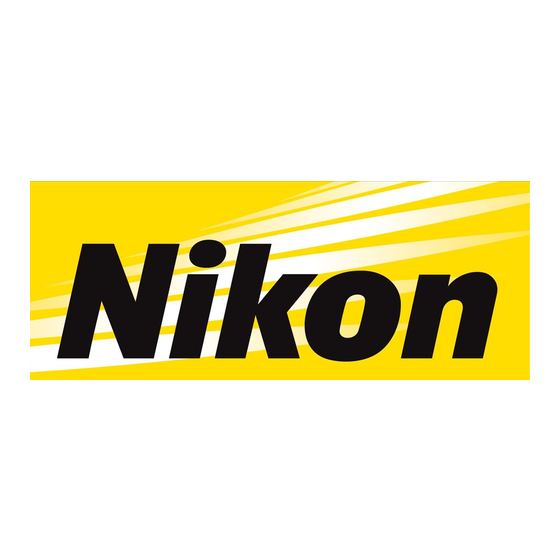Table of Contents
Advertisement
DSimaging
L LC
Note: These instructions were written for the microscope, equipped with a Diagnostic
Instruments SPOT camera, located in the Life Science Microscopy Facility at Purdue
University.
1. The Nikon E800 Microscope.
The Nikon E800 is a fixed-stage upright microscope configured to image in
transmitted light, DIC, and epifluorescence modes. The Nikon is equipped with the
following objectives:
2X/0.1 NA
Plan Apo -------
10x.0.45 NA Plan Apo DIC L
20x/0.75 NA Plan Apo DIC M
40x/0.9 NA
Plan Apo DIC M
100x/1.40 NA Plan Apo DIC H
The last objective (shaded) is an Oil immersion objective.
The condenser is: C-CU with 0.9 N.A. dry lens (swing-out) And contains the
following inserts: A(bright field) /DICL/ DICM/ DICH
DIC lens prisms are inserted above each individual objective lens.
The Nikon also has a filter cube slider with the following filter cubes (right to left):
1.
empty (VIS)
2.
Red (Rhodamine):
3.
11001 Blue (GFP longpass) 470±20/500/515
3.
41017 Green (GFP)
4.
11000 Ultraviolet ( DAPI)
Camera: the microscope is equipped with a SPOT RT slider CCD camera from
Diagnostic Imaging. It can be used as a B/W camera with the color filter sets
removed or as a color camera with the filters inserted.
Nikon E800 Operating Instructions
∞/-
∞/0.17
∞/0.17
∞/0.17
∞/0.17
560±20/585/620
470±20/495/525±25
360±20/400/420
1
WD = 8.5mm
WD = 4.0mm
WD = 1.0mm
WD = 0.11-0.23mm
WD = 0.13mm
longpass
longpass
narrow band
longpass
Oil
Advertisement
Table of Contents

Summary of Contents for Nikon E800
- Page 1 The condenser is: C-CU with 0.9 N.A. dry lens (swing-out) And contains the following inserts: A(bright field) /DICL/ DICM/ DICH DIC lens prisms are inserted above each individual objective lens. The Nikon also has a filter cube slider with the following filter cubes (right to left): empty (VIS) Red (Rhodamine): 560±20/585/620...
-
Page 2: Turning On The Microscope
Turning on the Microscope: 1) Sign in on the log sheet. 2) Turn on the main power and the camera power. 3) Turn the microscope power to “on”. 4) Turn on the Fluorescence power only if you plan to use fluorescence imaging. Please note: fluorescence bulb needs `30MIN to warm up to full illumination. - Page 3 Parts of the microscope: Neutral density filters to adjust illumination if required. They can be used in any combination to adjust the illumination so that it is comfortable for your eyes.. Push lever down to engage filter. Filters are marked ND2, ND8, & ND32. They can be used in any combination.
- Page 4 Adjusting the microscope for Koehler illumination. 1) Insert a sample and focus it using an objective that you typically use for imaging. Tip: Focus on the edge of the coverslip to set the course focus. Then focus up and down using fine focus to locate sample.
- Page 5 Taking an Image in Brightfield Mode: 1) Complete the Koehler alignment. Find an appropriate area of your sample and focus. 2) Open the SPOT Advanced program. 3) Select Brightfield-grayscale or brightfield-RGB in the lower right of the SPOT screen. 4) You need to do a color balance to show the camera what is white if you are doing color imaging.
- Page 6 Adjusting the microscope for Nomarski DIC imaging 1) Select DIC grayscale or DIC color on the lower left of the SPOT camera program window. 2) Make sure the camera filter selector is pushed in for grayscale or pulled out for color. 3) Insert and, using the LIVE mode on the camera, focus on a sample using the objective you intend to use for your imaging.
- Page 7 10) From the Setup menu, use “Setup > Image setup” to get into the dialogue boxes to adjust image. a. Select “modify” in Setups dialogue box. b. Select Exposure dialogue box and make sure “auto” is selected. It should also be set to: 8-bit for grayscale...
- Page 8 Fluorescent Imaging 1. Align the microscope for Koehler Illumination as described above. 2. Locate your sample using either brightfield or Nomarski DIC imaging. 3. In most cases, the fluorescence signal is not bright enough to use camera live imaging to focus.













Need help?
Do you have a question about the E800 and is the answer not in the manual?
Questions and answers